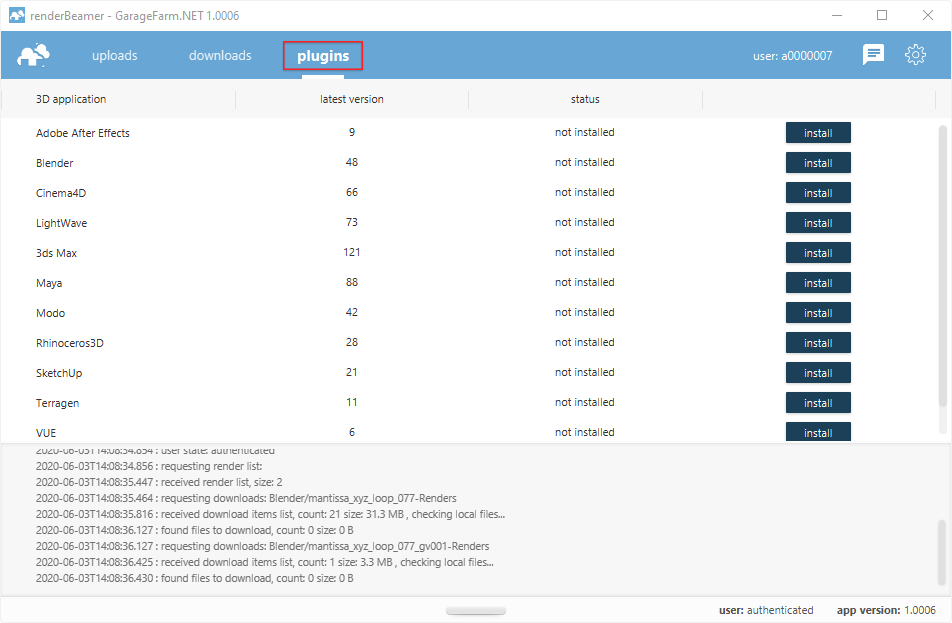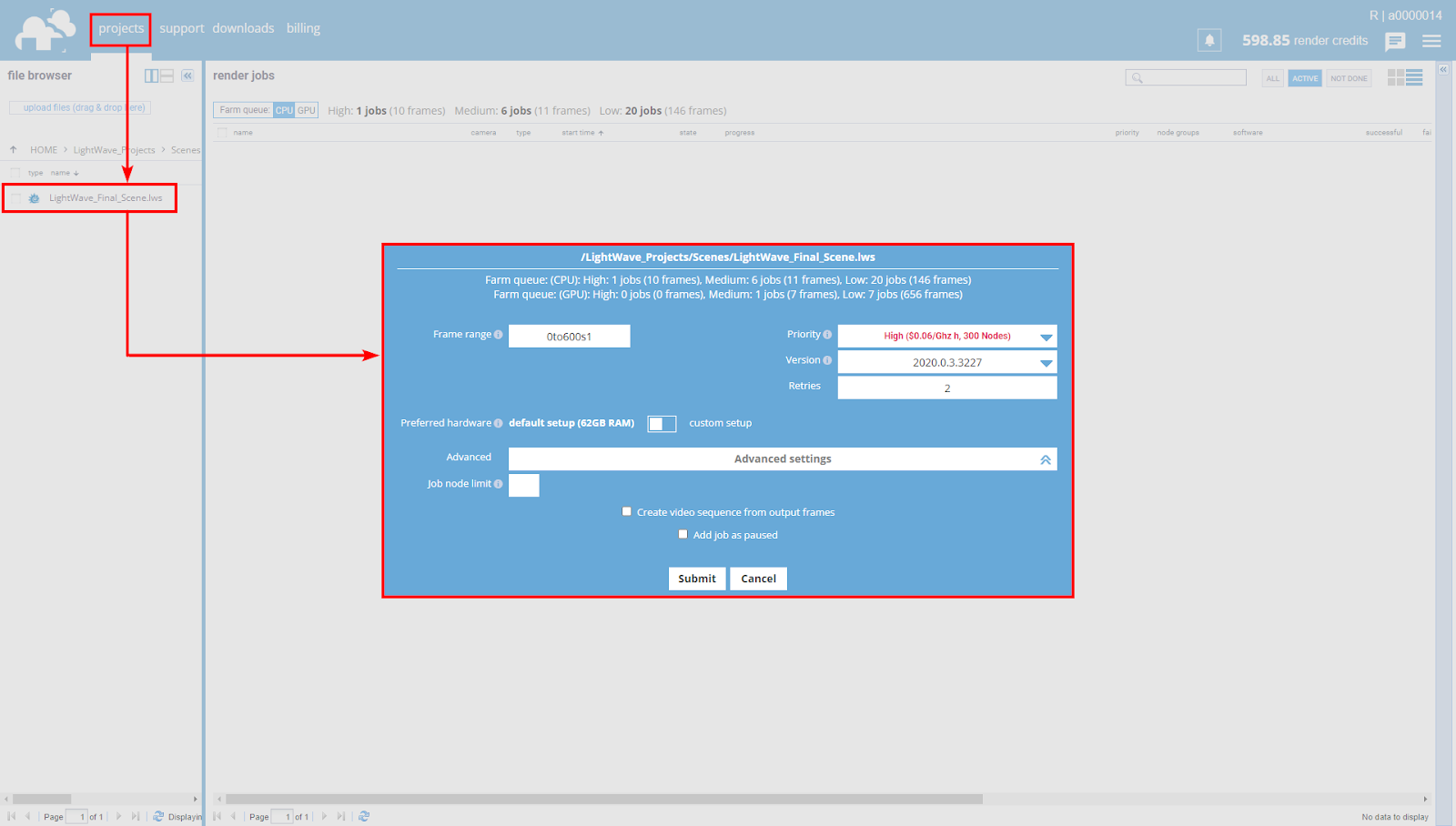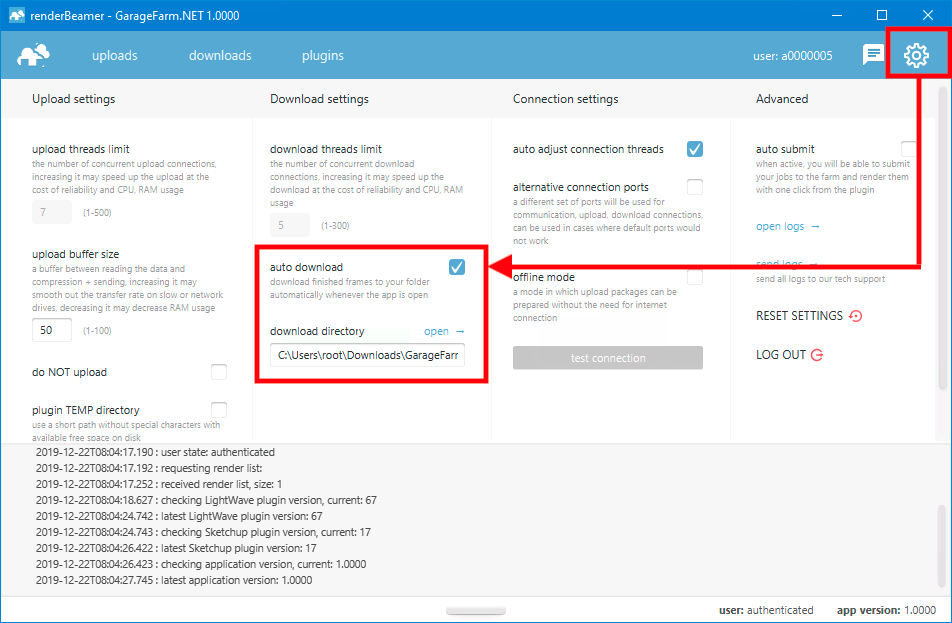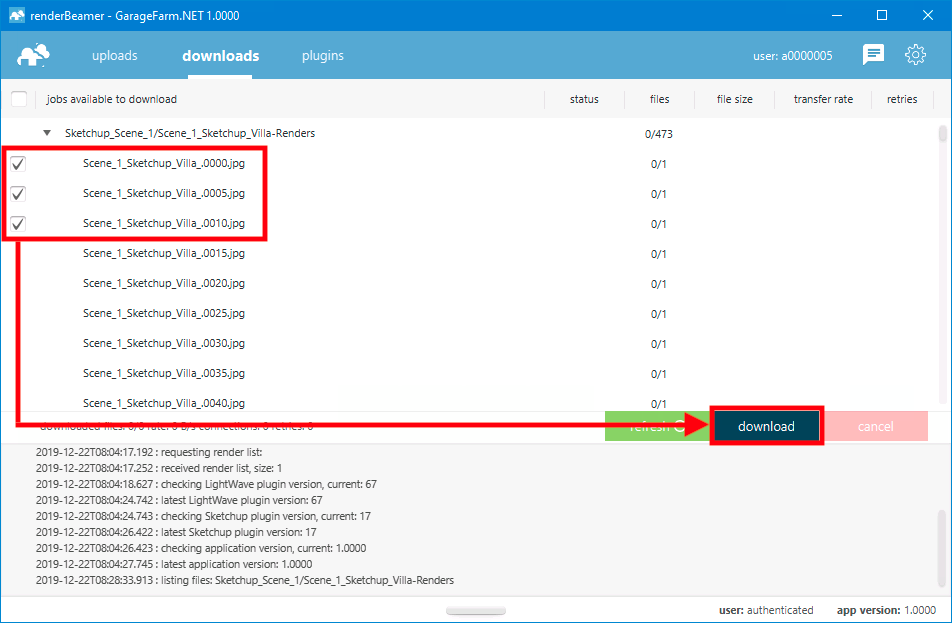HOME
Workflow & app guides
Articles
FAQ
Log in to Web Manager (web dashboard) at https://app.garagefarm.net and download our renderBeamer app for you operating system.

Install the renderBeamer app and start it. Once renderBeamer is done with the installation process, you need to choose the default download directory. This path will be used as the main output place for all your renders. Next, just log in using the account ID you received or your account email. Please keep in mind that the app should always be running in the background whenever uploading a project or downloading rendered frames.

Once renderBeamer is installed and you’re logged in, you’ll see the Plugins panel. Plugins installation panel should automatically open after the first renderBeamer startup. You can also open it anytime you need to install additional plugins for your 3D apps.

Here in the plugins panel, you can install plugins that allow you to work with our farm. Once you installed the plugin for your 3D app, you can proceed to the next step.
Note
Please keep in mind that each 3D app (DCC) you use needs to have a plugin installed to properly connect to and render on our farm.
Open your scene in LightWave layout and prepare it for rendering on a render farm.
After installing renderBeamer and LightWave 3D plugin, you should receive renderBeamer options available under the Render tab.

TIP
If you don’t have renderBeamer sub-menu, that means your LightWave was unable to automatically add the plugin to Layout. In such case, you need to add renderBeamer plugin manually. We suggest checking the solutions in this article to help you fix the issue.
To continue, just load your project and prepare it exactly as when rendering on your local machine. This should also include configuring render outputs and custom compositions for them.
When the scene is prepared, please run our plugin by clicking “renderBeamer”. Our LightWave3D plugin is a “one button” solution. You don’t need any additional setup to render your scene on the farm. Everything – including frame range, resolutions, selected camera, quality settings and output format will be rendered just like the settings you have in the scene. That also includes additionally supported render engine – Kray. Kray settings like render buffers and linked GI files will also be forwarded to farm.
!!IMPORTANT!! Due to LightWave3D issues with rendering animated assets, we strongly suggest using image sequences! This is a known bug that has been reported to NewTek, and hasn’t been fixed yet. Also, image sequences setup resets the start and end frame options when saving and loading the scene on another machine (even on the exact same LightWave version!). Because of that you need to contact our support (available via Live Chat or Skype) and ask to fix the start/end frame image sequence setting before submitting the scene to render queue!
Once our plugin completes the scene export, your project will be redirected to renderBeamer to be uploaded. renderBeamer is a standalone uploader/downloader application that works in conjunction with our plugins. Simply put, it takes care of the file transfers.
After the scene has been fully uploaded, the app will show you a window with a direct link to your scene on Web Manager (web dashboard). To continue just use click here to submit job button. If for some reason you closed the window with the link or it didn’t work, don’t worry, you can locate your project in the web dashboard and submit your scene by clicking on the scene file later (more on that in the next step). You can also copy link to clipboard and manually paste it into your web browser.

Now that your project is uploaded you will need to follow the final step - creating and submitting a job to render farm. Web Manager is a home to all your projects and render jobs.
If you followed the link generated earlier by renderBeamer, you will now see the job submission window with several fields and settings. If you didn’t follow the link or it didn’t work, you can do it manually by locating your project in the projects panel, finding the scene file within the project folder (in your folder structure look for the folder called “data”, i.e. Project_name/Scenes/SceneName.lws), and clicking on it to open the job window.

Our system automatically detects your settings in the scene and uses them to render the job. Before submitting the job to the render queue, please make sure that everything is correct and make adjustments if necessary.

Frame range - use this field to put in the frame range you want to render. Frame range example for animations: 1to740s1 - this is a sequence of 740 frames in total and all the frames 1 to 740 will be rendered. The parameter "s1" means that every subsequent frame in the given range will be rendered. If you want to do a test first, set a higher s value, e.g. "s20", which will result in every twentieth frame in the animation range to be rendered. So if you set the range to 1to740s20, then the frames 1,21,41,61,81,101,...,741,761 will be rendered.
If you have multiple cameras in your scene and you’d like to modify the frame range for all of them at once, you need to tick the checkbox to enable the frame range field.
If you only want to render a single frame (still image), you should input a single frame number into the field. For example, 1 will render the frame number 1.
Note
If you are going to render an animation or a still image, we always recommend that you perform a test before the final rendering:
- For animations, the best way to get a cost estimate is to run a test of the scene on the farm with around 20 frames spread evenly across the range. For example, a frame range 1to200s20 will render every 20th frame as a test and based on that our system will produce a cost estimate for the full render.
- For stills, please render the image in 1/5 resolution or any other smaller resolution. In the case of 1/5 resolution test, the cost of full resolution render will be 25 times bigger than the cost of a test. For example, if you want to render an image in resolution 5000x6000, run a test in 1000x1200 res first. If your test costs $1, then the estimated cost for the full res image should be around $25 (5 x 5 = 25). For a 1/4 test it would be $16 (4 x 4 = 16) and so on.
There's more information about running tests and estimating the cost in our documentation.

Priority - before adding a job to the render queue, you can decide how you want to prioritize it. Depending on the queue and farm traffic, a higher priority may allow your job to quickly acquire nodes to render your project faster. Each priority has a different rate and gives you a different number of nodes - a detailed list can be found here: https://garagefarm.net/pricing
Version - by default, the version of LightWave is set to the same version you have uploaded the project with. However, if you need to use a different version of LightWave than the one detected, you can choose a specific version available on the list.
Retries - the value for this option is set to 5 by default. This means that if a rendering process fails or the software crashes, our system will perform two additional rendering attempts. We recommend leaving this option set to default (value 2) as this is the optimal setting to retry rendering in the case of some random 3rd party software errors.

Preferred hardware (node groups) - by default, the system sets the preferred hardware to nodes with 62GB RAM. As we render LightWave projects on a CPU device, you can switch the node group button to a custom setup and select the particular group of nodes either based on CPU cores or RAM:

The full technical specification of nodes can be found here: https://garagefarm.net/pricing#specs
TIP
If you know that your scene requires more than 62GB RAM, then when adding a job to the queue select the group with 121 GB RAM or more to render more optimally only on nodes that have more RAM.

Advanced settings
NOTE
The advanced settings above are empty by default, please do not modify them without consulting support first.

Job node limit - by default, the value for this option is empty and so the nodes are assigned automatically depending on the job priority and nodes availability on the farm. Nevertheless, if you want to limit the number of nodes for the given job, please put here the value of the maximum number of nodes you want to be used during rendering.

Add job as paused - if you tick this option and then submit your job, it will be added with the status “paused”. This means that it will not start rendering automatically. It is useful to use this option if you intend to add the job to the queue, but you do not intend to render it at the moment. After adding a "paused" job, you can resume it at any time by selecting the "resume job" option (right-click on the job).
Submit - when you press this button, the system will immediately add the job to the render queue. Please remember to check all settings before submitting a job!
Cancel - if you do not want to add the current job to the render queue or you want to reset your settings and add the scene again, you can use this option. The submission window with the settings for the given job will be closed and all changes will be cancelled.

Create video sequence from output frames - You can create animated video outputs right after rendering frames. Select “Create video sequence from output frames” switch and set all desired video output settings. With the switch ON, the farm will run an additional job to render the frames sequence to a single video output.

More info about the settings available in the "video sequence job" you can find in our dedicated article.
After giving your render settings a final check and choosing your preferred priority hit Submit to add your job to the render queue. If you’re a first time user, you will have received $25 worth of credit to test out our service. The credits should be enough to run a few test jobs and get you familiar with the service.
TIP
You can right click on the job to get additional options: change priority, pause job, kill job, clone job, and archive job.
NOTE
The estimate is based on the currently finished frames, and is an approximation at that point. Rendering a test as prompted in the plugin (using a step i.e. 1to100s10) is highly recommended for more accurate estimates and for detecting potential errors.

When the job has started rendering, you can check the real-time progress of currently processed frames. To do that, just select the render job from the main project list and then click the arrow on the top right side to open the progress panel.

The Progress Panel (the panel on the right side of the screen) will show its content only when any of the jobs is selected. The panel is divided into 3 sections.
Active frames - it shows currently rendering frames. When a frame finishes, it is moved to the second section Done frames. If you select any frame in the Done frames list, you can then access the render output process log in the bottom section called Process results.
TIP
When you’re in the Progress Panel and right click on any of the currently rendering frames in the “Active frames” section, you can access the real-time render log from our nodes.
NOTE
Please keep in mind that if a job has finished rendering, the frames list in the “Active frames” section will be empty because all frames are already rendered and the list is moved to “Done frames”.

Each frame that has completed rendering is downloaded automatically to your local drive to a directory you selected in the renderBeamer application. If you’re not sure where your download folder is located, you can double check it or change it in renderBeamer’s settings (click on the cogwheel). Also, make sure you have auto download turned on to get the frames downloaded as soon as they are available. If this box is unchecked, you will have to click on each job in Beamer's "downloads" tab, and manually download the frames.

If you prefer more control over what to download and when, you can also download your frames manually. To do that, just turn off auto download switch in renderBeamer settings and go to the “downloads” tab. Next, select the desired render output using a checkbox, and click the download button.

This workflow will download all rendered frames for the selected job or jobs. However, renderBeamer also gives you an option to download individual frames. You need to use the list files function under RMB to do that

Once files for the selected job are listed, just roll down the list and select the files you’d like to download using checkboxes. Next, use the same download button.

Once your frames are downloaded, you can use open directory option under RMB to open the folder where frames are saved.
Note
Please make sure you keep renderBeamer running whenever you have jobs rendering to get the frames downloaded right away. It may happen, however, that your frames aren’t downloading in the given moment, and most likely that’s because our application checks for the files on the server in 15 minute cycles and it is currently in between the cycles. You can click refresh list to force the check without waiting for the next cycle.
You’ll need to charge your account to continue using the service when you use up all your trial credits. Please note that when your balance goes below $0, you won’t be able to download rendered frames or start new render jobs. You can make payments in the Billing panel in Web Manager. We accept debit cards, credit cards, PayPal and DotPay payments. Also, you can purchase credits via Revolut or Zen.
If your rendering needs are high or you plan to render regularly, please make sure to check out our volume discounts.

Note
In case your account balance goes below 0, any current jobs will be paused - all frames/strips that were in the middle of rendering will be completed but any subsequent frames/strips will not start rendering. To download rendered frames, your account balance must be positive or equal to $0.
You can talk to GarageFarm.NET’s tech team any time of the day, any day of the week. We’re here to help you get started, answer your questions, and assist you in any way. Don’t hesitate to give us a shout.
You can contact us through our live chat accessible in the web dashboard or our desktop app when you log in to your account or message us here through the guest chat.
We also recommend checking out our FAQ page which answers most of the questions new users have.